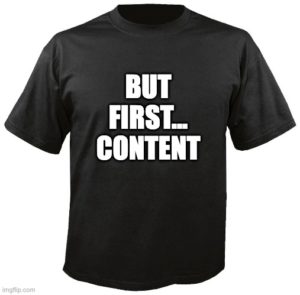“Gee, looky here! A brand-new widget from a brand-new company that I’ve never heard of, AND my colleagues have never heard of, AND the internet has apparently never heard of. I am IN!!!”
— said nobody, ever
If you’re in the early stages of starting a business, it’s time to get your startup marketing plan ready. It’s true that some great startup stories involve word-of-mouth networking that leads to a skyrocketing customer roster leading to global expansion and Series D investors in what seems like a matter of minutes. But even these unicorns need to devote time and money to marketing efforts if they want longevity.
Also, you’re probably not rolling in a big-time marketing budget yet. So it’s paramount to allocate your dollars effectively to get your brand, offerings and value prop in front of your ideal audience.
Startup marketing: First, be where your potential customers are
Everyday, millions of people are typing (and tapping) keyword searches that land them on search engine results pages (SERPs) featuring websites that can help solve their problem or answer their questions.
They’re also visiting social media, online magazines, industry group websites … you get the idea.
Your customers are online.
As a startup, what’s the best way to ensure your website is carving out a digital presence with these prospective customers?
In most cases, both organic SEO and paid search tactics are beneficial to help startups drive web traffic and online visibility. Here, we’ll explore the various goals organic SEO and paid search can help you achieve, and key considerations for maximizing the effectiveness of each approach.
What is organic SEO?
Organic SEO (search engine optimization) refers to a set of digital marketing techniques that naturally draw traffic to your website and elevate your online visibility.

Organic SEO is slow to start, but extremely effective over time. Think of it like planting a garden for future goodies.
Content marketing (e.g., blogs, case studies, ebooks and email marketing) underpins organic SEO. There are also technical aspects of SEO that are important to keep in mind.
Organic SEO is thought of as “free” because you aren’t directly paying for clicks or conversion. Keep in mind, though, that you’ll probably need to pay someone to develop a technically optimized website, write great content and possibly manage your social media, unless you have the time and expertise to do that yourself.
Why startups need organic SEO
Gain repeat traffic. High-quality content that’s optimized for keywords relevant to your products or services AND, most importantly, answers to questions your audience actually cares about, should naturally attract website visitors who want to return to your site.
Build trust. Position your brand as a trusted authority in your field.
Establish a digital foothold. Increase awareness of your brand and offerings by strengthening your online presence.
Do it all sustainably. Any effort or budget you put toward organic SEO will continue to pay off in the long-term in the form of traffic and visibility – even on content that is months or years old.
Drawbacks of organic SEO
You need to wait to see results. Think of growing anything: it takes time, care, and feeding. Same with organic content. Eventually something beautiful will grow (i.e., increased traffic, brand awareness, leads and conversion). But you need to be patient and wait for your efforts to take root – at least several months, typically.
It requires ongoing attention. You’ll need to consistently publish fresh content that matches keyword trends and emerging topics in your industry. Also, Google frequently changes the rules around how its search algorithms rank content, so someone needs to stay on top of that and pivot accordingly.
What is paid search?
You might also hear paid search referred to as search engine marketing (SEM) or pay-per-click (PPC) advertising.

Paid SEM is fast – you’ll see results immediately and you can make tweaks on the fly, but it’s gonna cost ya.
PPC advertising falls into a few major categories:
With search engine platforms like Google Ads or Bing, marketers bid on keywords their target audience is likely to search. Then, if Google’s algorithms determine that the ad and corresponding website content are a high-quality match, that ad will appear in one of the top sponsored spots in search results for that query. Advertisers pay only when someone clicks on the ad (hence, pay-per-click).
Social media platforms also allow marketers to purchase ads to get in front of targeted audience segments. (Pro tip: you should accumulate both a decent understanding of the platform and at least some organic followers before investing in paid social ads.)
Digital ads (e.g., such as on Google Display Network) give you the opportunity to buy ad space on websites where your target customers are likely to hang out.
Why paid search is an important marketing tool for startups
Quickly gain traffic. You can immediately see results in terms of increased traffic – crucial to helping start-ups gain traction on the SERPs.
Precise targeting. You’re able to target the exact audience you want, and customize your ads accordingly. Both search engine platforms and social media sites allow you to narrow your audience by demographic information.
Validate market interest. You think you’re product is totally groovy. But will your target market? PPC campaigns, with their ability to reach finely segmented audiences, can be a valuable tool for gauging interest in your offerings, and assessing whether you’re pursuing the right market.
Get quicker conversion. Paid search ads allow you to get in front of prospects when they’re actively looking for a solution to a problem and ready to make a purchase.
Gain insights through testing and measuring. It’s easy to run split-tests on PPC campaign elements (e.g., landing pages and CTAs) to see what performs best. You can apply what you learn to organic SEO efforts, too.
Drawbacks of paid search
Cost. All those tantalizing benefits come with a price, literally. PPC campaigns can substantially eat into a startup marketing budget.
Time. Being able to track, measure and then improve ad performance is a definite positive, but a couple things about that:
- It can be very time-consuming.
- For startups just jumping into the paid search fray, there can be a steep learning curve when it comes to understanding the metrics and how to effectively optimize ads for better performance.
And the winner is…?
Both, of course. Here are some tips and considerations for how startups can best use organic and paid search tactics.
Organic SEO best practices for startups
That you need a professional, appealing website and original content may seem like stating the obvious. In any case, here are a few must-do’s to check off.
To gain a foothold, you need a solid website to stand on
- Does your website accurately reflect your brand, product and services? Answer: What do you offer? Who is it for, and why do they need it? Why should people trust you?
- It’s gotta look good, and we’re talking form and function. Once visitors land on your site, get them to stay with visually appealing design, inviting copy, and a great user experience that includes web accessibility. (Psst: Time spent on site correlates with higher position on SERPs!)
- Make sure it’s technically optimized. Page loading time is a biggie here, but there are other points like eliminating broken links and having well-structured URLs. Get more tips on technical SEO here.
- Assess and improve performance by looking at web analytics on metrics like:
- Unique visitors
- Bounce rates
- Time spent on page
- Exit pages (which pages visitors tend to drop off from)
A content marketing strategy is crucial

Blogging. The benefits of blogging to attract organic web visitors can’t be overstated. You can also use your blog to generate leads and build email lists by inviting visitors to subscribe. One seasoned marketer estimates that it takes about one hundred blog articles to start seeing conversions. (Tip: It’s extremely helpful to establish an editorial calendar for blog content, and there are tons of free templates available online to help you do this.)
Pillar pages. Also called topic pages or content clusters, pillar pages provide in-depth information on core challenges your product or service helps solve. They link out to related sub-topic pages on your site. Pillar pages help drive organic SEO by being keyword-rich, positioning your site as an authority, and building internal links.
Newsletters. Newsletters can be a valuable part of an email marketing program, serving to build engagement and trust. Keep them quick and dirty, linking out to news articles from other trusted sources and to your own blog (or case study or white paper or press release or whatever piece of content you’re teasing).
Case studies, ebooks, videos and whitepapers are all great resources that make your site more content-rich. They can also serve as incentive for CTAs in your paid search ads and landing pages.
Social media. Although Google explicitly states that social media is not a factor in ranking sites, using it correctly can indirectly benefit SEO. By targeting the right people on the right platforms with valuable content, you can gain clicks and increase time spent on page and time on your site, which do influence search rankings. And building a community and interacting with followers gives you insight into content development and keywords to focus on.
Make your content compelling
Deliver value. Think about topics that will help readers tackle challenges common to their industry, stay on top of emerging trends and research, or otherwise be a superstar at work (or life in general!).
Present an exciting solution. What differentiates the way your product can solve user challenges? How will users’ lives be easier, more efficient, more enjoyable?
Tell a story. Humans are hard-wired to love a great story. Don’t be afraid to get relatable with your audience – building authentic engagement is a major goal of content marketing. Stories are a powerful way to do this.
Learn how start-ups can best leverage paid search
Despite its reputation as a potential budget hog, PPC doesn’t have to be. It’s especially critical for startups to know how to use it without accidentally breaking the piggy bank.
Wordstream has a great article on how startups can use PPC effectively. Here are a few suggestions distilled from that to help maximize return on investment for your PPC spend:
- Take the time to learn how PPC works, including ad auctions, bidding, keyword selection, structuring a campaign and tracking conversions.
- Create campaigns based on the problems you solve, not simply on the products and services you offer. This should drive your keyword strategy, ad creative and landing page content.
- At first, keep your ad account simple – focus on top-priority keywords, create one campaign around your most important keyword, and build out ad groups from there.
- Keep your offers learning-focused, e.g., “Learn about plans and pricing.” Main reason? It’s early days, and you need to earn trust and audience awareness before ad viewers are ready to commit to more aggressive asks like “Start your 30-day trial.”
- Provide great content (see above tips on compelling content). Your ads and landing pages need to link to high-quality content that further engages visitors. (Are you starting to see how PPC and organic content are intertwined?)
Shift your approach over time
As you expand beyond startup mode, organic SEO will always be a priority. But remember: it takes time to get the SEO momentum rolling. To compensate, you can start heavy on PPC (assuming you have the budget), then pull back as your SEO efforts take hold, but keep PPC in your back pocket for:
- Marketing campaigns that require highly targeted traffic.
- Dominating SERPs for your most important keyword categories. (Because PPC ads always appear above organic results, a high percentage of search traffic will click on these top placements.)
- Product launches, event promotions, seasonal offers and key content distribution…anything time-sensitive that needs immediate traffic flowing to your site.
Focus on nurturing leads
Once you do have some leads converting from paid ads or organic efforts, you’ll need a lead nurture program to keep them engaged with your brand and build a relationship.
Outreach needs to match engagement
As the name suggests, nurture campaigns should be gentle, not aggressive, taking the form of a slow but steady stream of helpful information that complements content that users have interacted with already.
For example, a paid search visitor converts from a landing page where you’re offering a white paper in exchange for an email address. Appropriate nurturing at this stage might include content like:
- The positive business outcomes your users can expect
- Company news that would build trust (e.g., new investors, case studies)
- An invitation to learn more by downloading another asset
Now, go forth and use SEO and SEM together to make the most of your startup marketing efforts!










